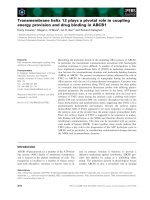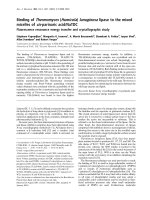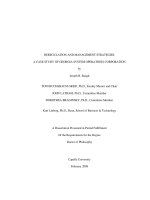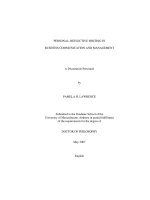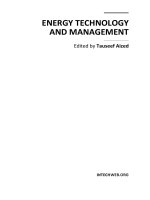Energy audit and management
Bạn đang xem bản rút gọn của tài liệu. Xem và tải ngay bản đầy đủ của tài liệu tại đây (1.4 MB, 65 trang )
Energy Audit and Management
Prof. C. S. Solanki
Department of Energy Science and Engineering
Definition of Energy Audit
It is a systematic research of energy conservation
opportunities as well as a systematic approach to
measure energy level of plant. It is an effective tool
in defining comprehensive energy management
program.
In general Energy Audit is the translation of
conservation ideas into realities, by blending technically
feasible
solutions with economic and other
organizational
consideration within a specified time
frame.
NEED FOR ENERGY AUDIT (EA)
Identify all the energy streams in a facility and to
quantify energy use
Indicates where the major potential for improvement
Identifies the cost of energy and where and how it is
used.
It provides a base from which results can be
measured and from which programmer can be further
developed.
OBJECTIVES OF ENERGY AUDIT
• Assessment and reduction of electricity bill
• Identifying potential areas of electrical energy
economy
• Assessing present pattern of energy consumption
and optimizing energy consumption level
• Highlighting wastages in major areas
• Recommending energy saving measures with
minimum possible investment and realization of
savings.
Comply with government regulations:
• The Energy Conservation Act 2003 (India), has identified 14
industry sectors and commercial buildings as designated
consumers. A comprehensive Energy Audit helps these
industries comply with major provisions of the act like:
•
Maintaining energy consumption within standard norms
Maintaining and reporting accurate energy usage patterns
Training of Energy Managers responsible for energy efficiency
of the plant
•
• The Energy conservation techniques can be understood by
studying the Energy conservation Act, 2003 (INDIA).
Major Provisions of the Energy Conservation Act, 2003
(India):
Industries in specific sectors, with connected load of 5 MW and
above and/or consuming 20 MT of oil equivalent per hour on an
average are notified as designated consumers. All commercial
buildings with connected load of more than 500KW are also notified
as designated consumers.
Designated consumers will comply with energy consumption
standards and norms. Different standards and norms are prescribed
for different designated consumers.
The Central Government, in consultation with BEE, can direct
designated consumers to conduct Energy Audits by an accredited
Energy Auditor based on a certain periodicity
Industries notified under the Energy
Conservation Act, 2001 (India):
1.
2.
3.
4.
5.
6.
7.
8.
9.
10.
Aluminum
Fertilizer
Iron and Steel
Cement
Pulp and Paper
Chlor Alkali
Sugar
Textile
Chemical
Railway
Conservation of energy through Auditing
•
•
•
•
•
•
•
•
Removal of discrepancies between the operating and the design
figures of energy consumptions
Improvement in process technology
Improvement in system design; change in temperature approach in
heat exchangers
Improvement in automations and controls for optimal utilization of
energy
Units/Systems integration: provision of a facility of one equipment for
the other
Incorporation of measures to improve efficiency such as cascading
of energy
Recovery of waste and low level heat, minimizing of losses, etc
Detailed study of measure energy consuming equipments for
possible energy savings by improving operations, improvement in
hardware design and replacement with more efficient hardware.
TYPES OF ENERGY AUDIT
The type of EA to be performed depends on
•Function and type of Industry
•Depth to which final audit is needed
•Potential and magnitude of cost reduction desired
There can be two types of EA
•Preliminary Energy Audit ( PEA )
•Detailed Energy Audit ( DEA )
PEA
Objective
DEA
Set priorities for optimizing
a) Quantify Energy consumption and
energy consumptions
utilization
b) Evolve detailed engineering for options
to reduce energy cost
Scope
Highlight energy cost and
Formulate detailed plan on the basis of
wastages in major equipment
quantitative evaluation
/problems
Duration
Audit
2-10 days
1 – 10 weeks
a) No pre audit visit required
a) One / two pre audit visits are required
b) Detailed questionnaire to be
b) In addition
completed before audit
Due date of Within 2 weeks of completion of
report
field work
-
Advance notice to HOD’s
-
Arranging office and secretarial support
-
Advance tentative schedule
-
Audit kit planning
Within 3 months of completion of field work
SCOPE OF EA
• The scope of an energy audit varies according to the
facilities being audited.
• At the extreme is a light manufacturing operation
where lighting ventilation and air conditioning are the
major energy uses.
• While at the other end there are integrated process
units like the refineries and petrochemical plants
where cascading of energy and complex energy
balances are involved.
Typical points considered in EA
. Analyze present consumption and past trends in detail
• Review lighting requirements
• Produce and energy balance diagram for the firm
• Check working of controls
• Check capacities and efficiencies of equipments
• Review energy storage and handling
• Determine adequacy of maintenance
• Introduce life cycle costing
• Examine need for energy saving incentives
• Examine and monitor new energy saving techniques
Energy Audit Team
1] Expert licensed engineers for auditing
2] They should have good knowledge about :
i)Process
ii)Operating experience of unit.
iii)The plant utilities and plant material and
energy balances and the assistance from
research and development wing should also be
available to them
Instruments needed for Energy Audit
The following are the typical instruments needed for
energy audit:
•
•
•
•
•
•
•
•
Power meters( Clip-on-meters and direct connected meters).
Power factor meters( clip-on-meters).
Lux meters—To measure the illumination level.
Energy meters, ammeters( Clip-on-meters also), Voltmeters.
Stop-Watch
Tachometer
Bearing stethoscope to see the conditions of bearings
Portable temperature indicators
15
Energy Audit methods based on
•Flow of energy – energy balance
• Flow of material - mass balance
CEOs
17
Table of Summery of energy saving
recommendation
18
Prioritize recommendations
19
Example: saving in terms of fuel
20

